Ever wondered about jet-setting with your beloved pet cat but didn't quite know how to go about it? Well, your worry ends here. We've tapped into the expertise of Sally Smith, the revered Founder and President of Companion Pet Enterprises. Together we have created a detailed guide for traveling with cats. We also bring you 36 invaluable tips shared by our community members over the years.
We'll cover topics like prepping your precious cat for car or plane travel and understanding the paperwork and health checks required for interstate or international travel. We will also provide practical tips on acclimating your cat to the carrier and making the journey comfortable.
But that's not it. We dive deeper into what professional pet transporters bring to the table, especially for more complex moves. Get insights into their licensing, security programs, and the whole gamut of services they provide.
Keep reading and uncover the wealth of information tucked away in this guide. Your cat's travel worries will soon be a thing of the past!
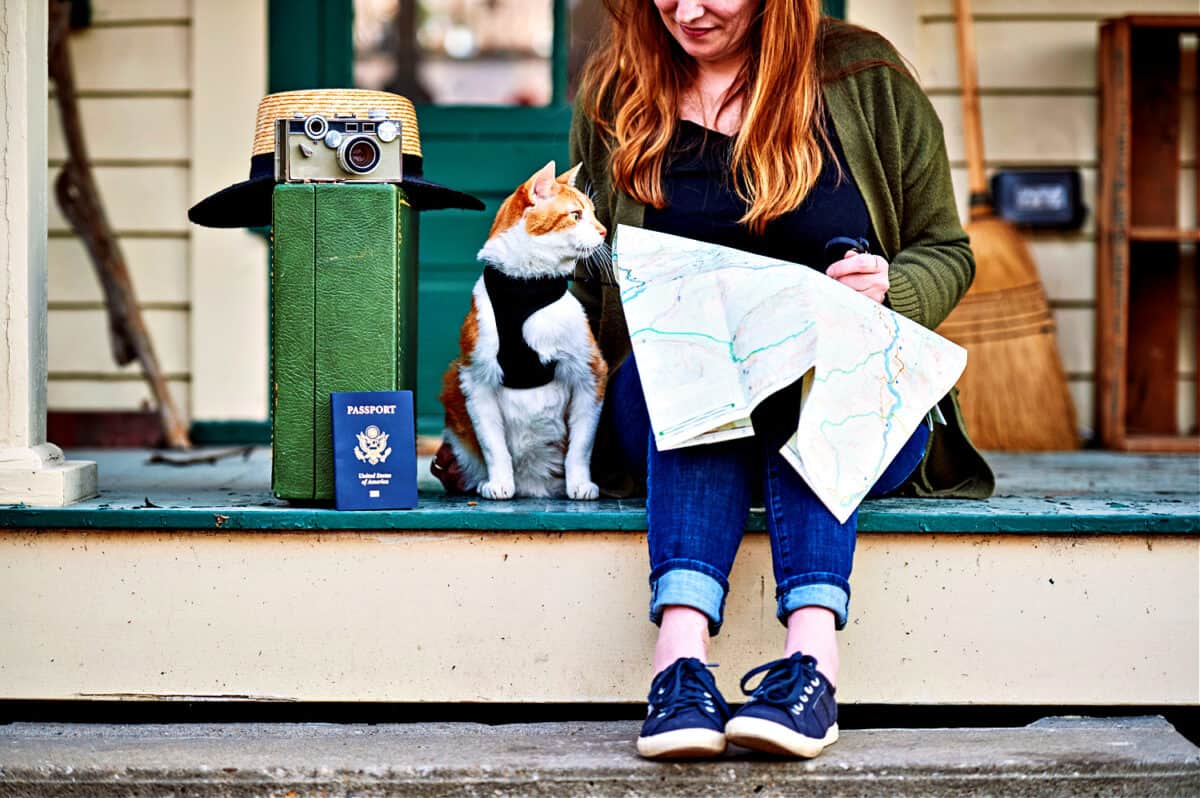
Traveling With Your Cat: Car Or Plane?
There are only two ways to move pets, by car or by plane. For interstate travel or travel to a neighboring country like Canada, your cat should first be examined by a veterinarian and have a health certificate issued prior to travel.
At border crossings, you may be asked if you have a certificate. If you are unable to produce one, they will hold you up a bit, while you answer all the questions as to why you were not prepared.
Traveling cross-country by vehicle requires quite a bit of time versus air travel. Some additional requirements for longer trips need to be considered:
Let Fluffy get acclimated and friendly with the cat carrier. Leave it open with bedding in it, in the room she is most comfortable in. Once the initial apprehension dissipates, kitty curiosity can take over.
If it looks inviting, is safe (meaning the door is propped open), and has treats inside, Fluffy should investigate it in her own time. If she does not, put her inside for a few minutes, then let her out.
Short interludes where nothing happens will help alleviate the fear of the carrier. Don't force her inside. If she shows any reluctance, stand the carrier on end with the door open and scruff Fluffy gently and lower her inside.
Close the door quickly behind her; gently lower the carrier to a normal position keeping her inside for just a few moments, then release her.
In order to prevent escape or accidents on the road, cats should always be transported in a carrier. To keep her calmer, if you are only going a short distance, you can alleviate some of the stress (if it is not a really hot day) and cover the carrier with a dark cloth.

How To Survive Long-Distance Travel With Cats
But for longer trips here are some easy tips to follow:
Planned Rest Stops
Stopping not only gives the driver a break, but also offers you the opportunity to check on your cat, and offer her the use of a litter box and a drink.
Before you open up the carrier, be sure all doors and windows in the car are closed. Let Fluffy out of the carrier, with the litter box on the seat or floor near the carrier, but don't be surprised if she won't use it.
Let her walk around a little bit before returning her to the carrier, but don't let her get underneath your seat where she will be hard to reach.
Time Your Trips
Plan to travel no longer than 7 or 8 hours (most cats can wait to relieve themselves for that period of time) and the box can be then offered in the safety of a hotel room. If your cat is prone to motion sickness, don't offer her any food while she is in motion.
Find Pet-Friendly Accommodations
Schedule your trip around hotels that accept pets. Call ahead of time to find out if the hotel or motel is pet-friendly. Several books and Internet sites serve as guides for pet-loving accommodations.
Have An Escape Plan: Keep identification tags on your pet. In the event of an escape, the person finding the cat will know whom to contact. Consider leaving a temporary tag with your cell phone number on it, just in case. Also, microchip your pet. Microchips provide universal protection.
Offer A Comfort Zone
If your cat dislikes auto travel of any length or tends to become car sick, speak with your veterinarian about using Dramamine or a similar product to control nausea. A product like Benadryl can make the cat sleepy without the dangers of tranquilization; however, do not use these products without your vet's recommendation.
Short & Sweet
Prior to the trip, take short trips with your kitty in the carrier around the block or to a local store. Plan to return home before the anxiety or motion sickness starts.
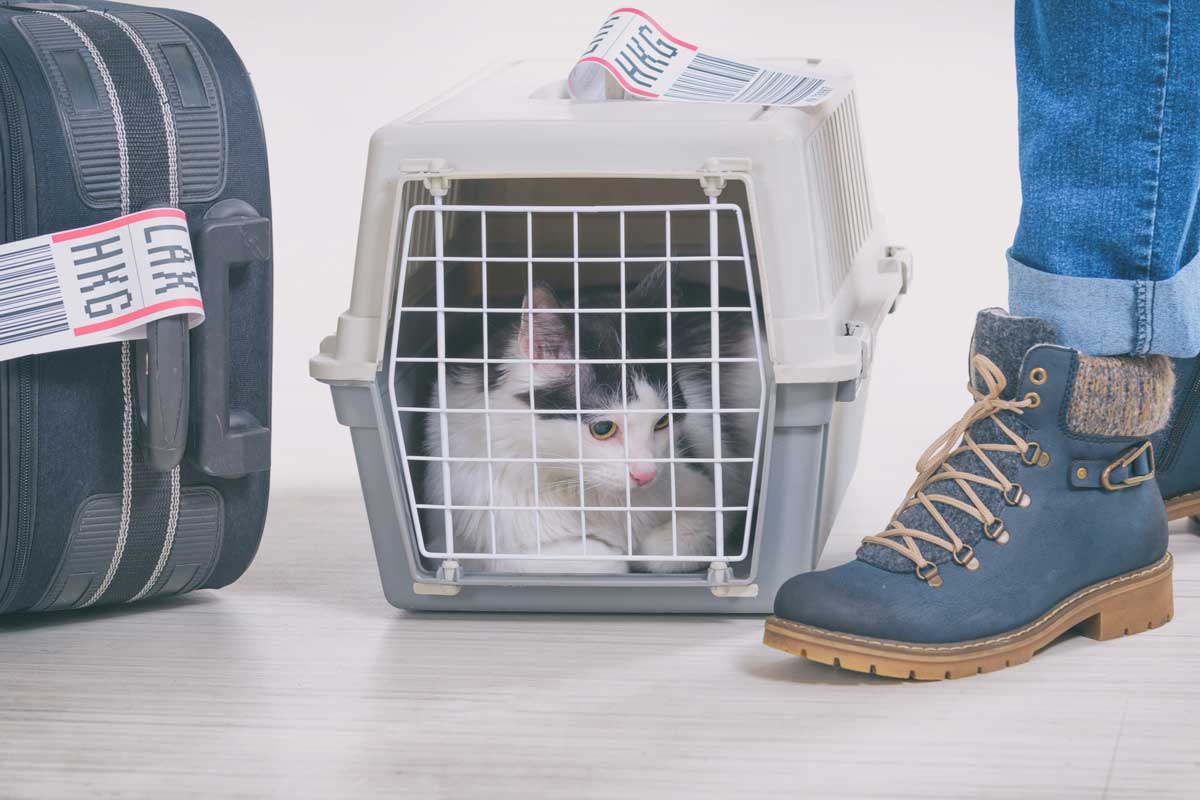
Travel By Air
Don't be surprised if you encounter difficulty booking your cat's travel. The Federal Aviation Administration has made security changes since the terrorist attacks that affect how pets are shipped.
Professional pet transporters have the necessary licenses to move pets with the airlines, but only a few airlines will currently still deal directly with the public. Depending on the airline, one or two cats may be allowed in the cabin as a carry-on or can be booked as excess baggage with you on the same flight in the cargo area of the plane.
Many people worry about the safety of their pets during air travel. According to airline estimates, nearly two million pets a year are shipped.
Each year there will be one or two well-publicized accidents to cause concern, but actual airline statistics report less than 30 animal injuries or deaths per year. Most accidents happen due to poor planning, improper crates, tranquilization, or human error. Sometimes things are truly an accident with no one to blame (unless the pet itself is to blame!).
Whether you have help from a professional or do it yourself, certain requirements for air travel need to be met.
Follow The Rules
An airline-approved shipping crate is required. For travel in the cabin, a soft-sided carrier may be used. But for travel as cargo or in the baggage area, the crate must be plastic with a metal door. It should be big enough for the cat to sit up, turn around and lie down.
The less expensive carriers are not the safest. The higher-priced crates are made of sturdier fiberglass, rather than plastic, and have stronger doors that will not fly open.
Each crate must be labeled with live animal stickers, consignee information, feeding instructions, and two dishes attached to the door. These are federal regulations that must be met.
Provide Timely Proof
Every cat needs a health certificate and proof of rabies vaccine. The Animal Welfare Act says the health certificate must be dated no more than 10 days prior to the trip. If it expires a new one will be required.
Say No To Drugs
The American Veterinary Medical Association and the Independent Pet and Animal Transportation Association do not recommend tranquilizing your cat for flying. It is now widely recognized that tranquilizers are the number one cause of illness and death in pets shipped by air.
Several airlines will now also refuse to accept a tranquilized pet. Better to have a pet soil the crate, but arrive safe and sound.
Travel by air is stressful no doubt, but healthy pets survive a few hours of travel quite nicely. Pad the bottom of the carrier with plastic diapers (padding turned up) to help absorb any accidents that might occur.
Weather Restrictions: Understanding Potential Delays
Excessive heat and cold can prohibit pet shipments. Each airline can put an embargo in place to prevent moving a pet when it is less than 45 degrees, or more than 85 degrees at either end or at any stop along the way if they will be exposed to these temperatures for more than 45 minutes.
Professional pet transporters and airlines must abide by these federal regulations. Therefore, even if you have your cat booked to go with you as excess baggage, temperatures may prohibit it from traveling on that day. This is for the health and safety of your pet.
Planning And Alleviating Travel Stress
Planning and common sense can alleviate most of the problems encountered when traveling with your cat. Fluffy may never love traveling, but you can help make it easier. For more complex moves the use of a professional pet transporter for air travel is not the least expensive alternative but maybe the best choice when moving the cat yourself becomes overwhelming.
The Benefits Of Professional Pet Shippers
Professional pet shippers are licensed by the USDA for interstate travel and have a TSA-approved security program. They will handle all the documents for arrangements with the airline and meet the FAA/TSA requirements.
Comprehensive Assistance: Before And After The Journey
If you must travel to the destination before you can send for your pet, oftentimes pet transporters can assist you with obtaining health certificates, veterinary requirements, or boarding.
They will be able to provide shipping crates as well as pick-up and delivery services from home to the airport.
A network of transport specialists may also even allow for a transporter to meet Fluffy upon arrival and deliver her to your new home. Most, but not all, transporters can assist with international relocations.
Navigating International Travel: Dealing With Unique Country Requirements
Each country has its own requirements for pets entering the country. In some instances, only a health certificate is required along with proof of a rabies vaccine. In other countries, it may be a long involved process requiring months of planning and or quarantine once Fluffy arrives.
These transporters are always knowledgeable about these rules and restrictions, after all, that is how they make their living.
SIGN UP FOR THECATSITE'S EMAIL UPDATES >
Keep Reading For Our 36 Actionable Tips Below!
Written by Sally Smith
Sally Smith is the Founder and the President of Companion Pet Enterprises, a pet transportation company and company dedicated to advising and helping others in how to move their pets both domestically and internationally. Smith is diversified in skills throughout the pet industry.
Working as a vet tech, animal groomer, and designing a pet care facility that offered all services in one fell swoop including pet transportation, she became the Director there for over 12 years. Her diversified background has allowed her to hold several positions among them serving on the boards for the New Jersey Veterinary Technicians and Assistants, the Independent Pet and Animal Transportation Assoc. and the American Boarding Kennels Association.
Her current clients consist of Microsoft, Johnson & Johnson, and Continental among others. She shares her experiences willingly and wrote this article in an effort to help all involved- the cat, the cat owner, and the transportation companies.
36 Actionable Tips By Our Members
Most cats are not good travelers. They like having their familiar established territory and couldn't care less about seeing the wonders of the Great Beyond. You're not very likely to ever come across a cat sticking its head out the window with its ears flapping in the wind...
But sometimes long-distance traveling with cats is inevitable. If a 20-minute car journey to the vet is a loud vocal nightmare, the prospect of spending long hours on the road with cats in the car can be absolutely terrifying.
Don't lose hope though. People do take their cats on long car trips and you can too.
Here's a collection of thirty-six tips, provided by TCS (TheCatSite.com) members over the years, that will help make road-tripping with cats safer and less stressful.
![Ginger cat walking out of blue cage, Traveling With Cats [Inc. 36 actionable tips]](https://thecatsite.com/c/wp-content/uploads/2011/11/Ginger-cat-walking-out-of-blue-cage-1.jpg)
Expert Tips And Wisdom For Road Trips With Your Furry Friends
On Calming Composure: Tip #1
Embody tranquility. Remember, cats are astute in sensing human stress. Avoid displaying signs of distress, like raised voices, to ensure their comfort.
The Journey Adjustment: Tip #2
Patience pays. Your cat may need an hour or so to relax in the new environment. A little howling during shorter trips doesn't necessarily translate into a whole day's worth of commotion.
Familiarity and Routine: Tip #3
Habituation helps. Gradually introducing travel routines to kittens or young cats can ease them into long journeys. However, with older cats, avoid adding unnecessary stress with new training.
Securing The Path: Safety Measures For Road Trips With Cats
The Carrier Rule: Tip #4
Have your cats in a large carrier or dog crate during the entire duration of the drive. Having a cat loose in the car is dangerous to both cats and humans. Road safety first! The driver should not have to deal with a cat squirming between the pedals or blocking the view of the windshield.
Harness And Leash: Tip #5
Cats should always wear a harness while in the car. Whenever they are removed from their crate or carrier, a leash needs to be securely clipped onto the harness. Train your cats to wear a harness in advance.
Window And Door Safety: Tip #6
Preventive measures are key. Keep cats securely harnessed and leashed before opening any doors or windows.
Rest Stop Routines: Tip #7
Cautious pit stops. Avoid letting cats out during stops unless they are well-trained to walk securely on a harness and leash.
Identity Protection: Tip #8
Have your cats properly ID'd. Their harness should have a name tag with your current mobile phone number on it. Microchipping your cat is also a good idea.
Medication Consultation: Tip #9
Prescription principles. Before medicating your cat for the trip, ensure you consult with your vet. Certain over-the-counter calming agents may not be cat-friendly.
Trial Runs For Medication: Tip #10
Homeward testing. In case of medicating as per vet advice, first, try it at home to check for any adverse reactions.
Ventilation And Temperature Control: Tip #11
Comfort in climate. Ensure your cats are placed in a well-ventilated area of the car, not exposed to strong winds or extreme temperatures.
Unattended Warning: Tip #12
Attention required. Never leave your cats unattended in the car, especially on days of extreme temperatures.
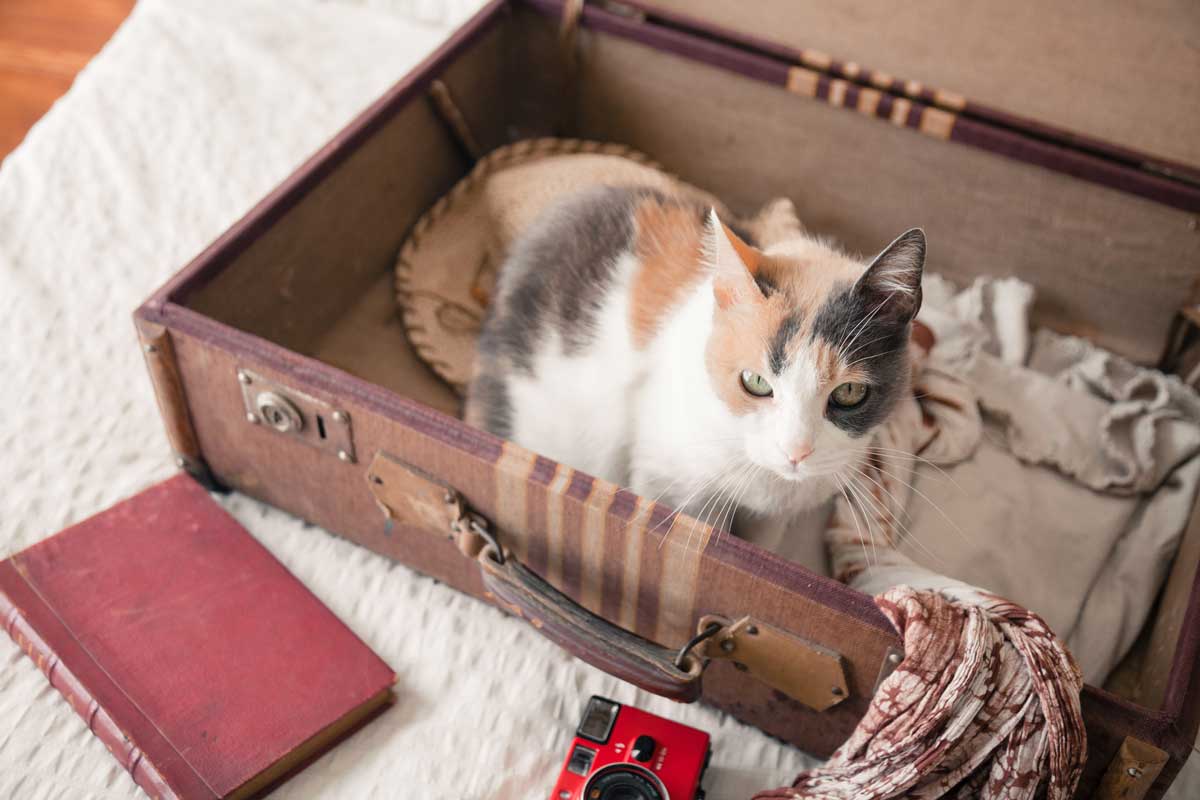
Crafting Comfort: Setting Up A Homely Environment For Cats
Crate Comfort: Tip #13
Give your cats room to stretch and move around. Opt for very large carriers, and preferably dog crates.
Car Play: Tip #14
If possible, cage a section of your vehicle and make that into the kitty playpen. Just make absolutely sure no doors or windows in that area can be opened by mistake.
Multiple Cats: Tip #15
If you use large dog crates, you can place more than one cat in each crate, provided the cats get along well with each other.
Vertical Space: Tip #16
Make the most of the vertical dimension of the crate by hanging a cat shelf inside it.
Privacy: Tip #17
Drape a sheet over the cage or crate, leaving one side open. This will make the cats feel more secure, as well as protect them from direct sunlight coming through the car windows.
Accident Prevention: Tip #18
Line the crate with pee pads, in case you have any accidents. Carry extras with you.
Familiar Scents: Tip #19
Place familiar blankets and cushions in the crate.
Cozy Comforts: Tip #20
Place a worn tee shirt of yours in the crate for the cats to have your scent around them.
Calming Scents: Tip #21
Consider using Feliway - spray the crates or use a diffuser in the car.
Click Here To See This Product On Amazon
Cat Toys: Tip #22
Take a few cat toys and rotate along the way. This is especially effective with kittens. Don't be offended if your cat avoids playing.
Road Tripping With Cats: Food, Drink, and Litterboxes
Cat Entertainment: Tip #22
Many cats do not eat, drink, or poop while on the road. Don't be alarmed by this, and just patiently wait for your final stop at the hotel.
Disposable Litter Box: Tip #24
Keep a small disposable litter pan in the crate. You can use aluminum baking pans and bring along a supply that will last for the duration of the trip.
Handling Accidents: Tip #25
Have wipes and strong plastic bags handy at all times, to handle litter box accidents.
Water Bowl: Tip #26
If you keep a water bowl in the crate, make sure it's deep and put very little water in it. You want to avoid spillage as the car turns and sways.
Alternatives For Water: Tip #27
Consider training your cats to use rabbit water bottles prior to the trip. You can do that by using chicken broth (no onions or garlic in it!) and some water in the bottle or rubbing their favorite moist cat food near the tip of the bottle. If they learn how to drink from that, it's a great way to make water available without risking wetting the bottom of the crate.
Food & Water Timing: Tip #28
If you prefer, you can limit water and food and provide them only during breaks, once every 4-5 hours.
Car Sick Cat: Tip #29
If your cat tends to get car sick, it's best to avoid feeding 2-3 hours prior to travel. You can feed them at night at the hotel. Many cats don't eat and drink during car trips anyway.
Foods: Tip #30
Only provide food your cats are familiar with and tolerate well. This almost goes without saying, but don't try new treats or pamper them with expensive foods that they'd never tried before.
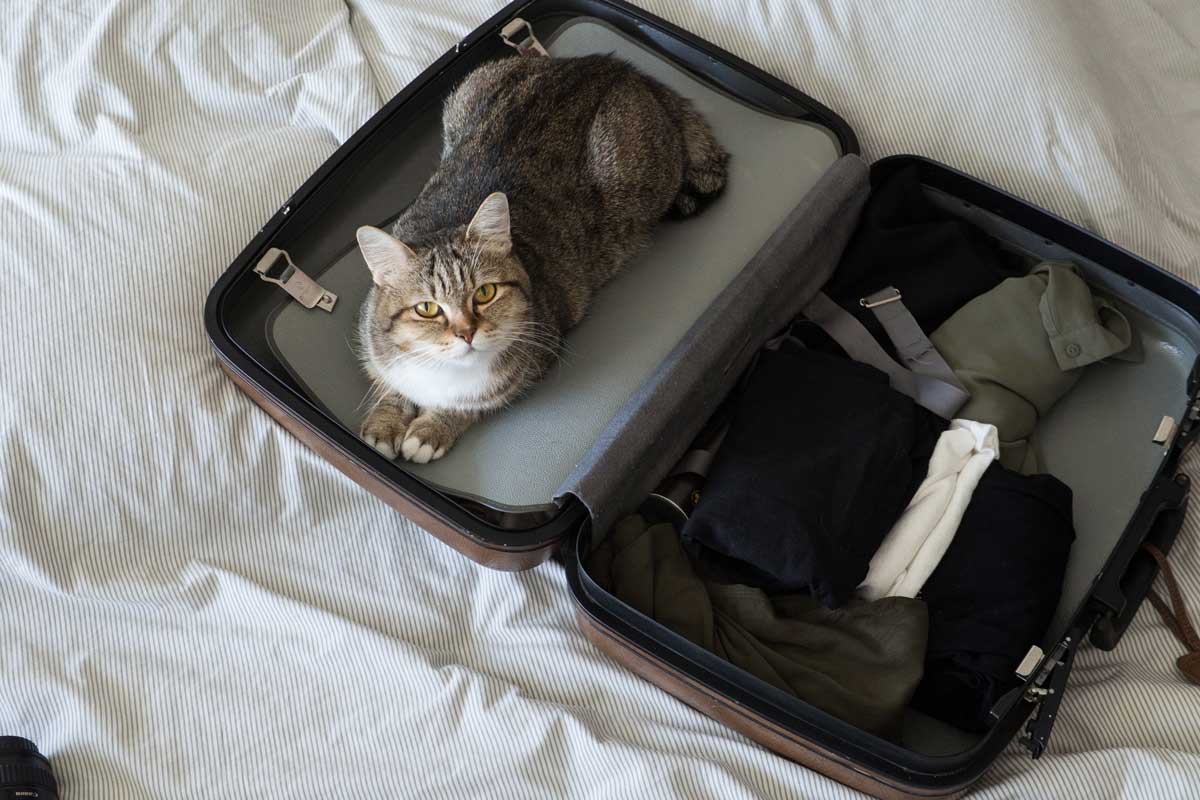
Beyond The Drive: Extra Tips For Road Trips With Cats
Planning Accommodation: Tip #31
If your trip is more than a day long, plan ahead for accommodation. Many motels and hotels are pet-friendly, though some ask for extra fees. Most Super 8's and all Motel 6's are pet-friendly. Call in advance to make sure they have room for you and your kitties.
Travel Documentation: Tip #32
Have vet paperwork handy for crossing state lines or borders between countries. Papers are rarely needed for crossing state borders, but at the very least, have proof of your cat being current on her rabies shots.
Handling Cat Communication: Tip #33
Don't let the meowing get to you. Most cats meow like crazy when they get on the road. Most also settle down after an hour at the most and go to sleep. You need to focus on safe driving and ignore the cries.
Driving Sensitivity: Tip #34
Keep your driving relaxed. Don't overtake unless absolutely necessary and take it easy when pulling out. Remember that cats are sensitive to acceleration, deceleration, and sideways motions. Changes in altitude may also affect your cats.
Traveling With Company: Tip #35
If possible, travel with a passenger that can help you take care of the cats.
Safety Awareness: Tip #36
Make sure any travelers are fully aware of safety issues and know not to open any doors or windows unless all cats are properly secured.
Wrapping Up: Journeying With Your Beloved Feline Companions
Navigating the open road with your treasured feline friends doesn't need to be a daunting task. This comprehensive guide has empowered you with the essential tools and knowledge for a smooth and stress-free journey.
Armed with these actionable insights, you're ready for your road trip, ensuring an enjoyable and memorable journey for you and your feline companion. May every mile be a stride toward making precious memories, and may the road always lead you both safely home. Happy travels!
SIGN UP FOR THECATSITE'S EMAIL UPDATES >
Comments? Leave them using the comment section below. Questions? Please use the cat forums for those!
![Ginger cat walking out of blue cage, Traveling With Cats [Inc. 36 actionable tips]](https://thecatsite.com/c/wp-content/uploads/2011/11/Traveling-With-Cats-Inc.-36-actionable-tips.jpg)
Note: We may get commissions for purchases made through links on this page.



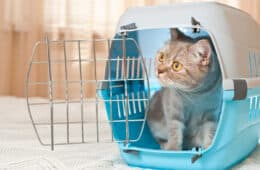

2 comments on “Traveling With Cats [Your Ultimate Guide & 36 Game-Changing Tips]”